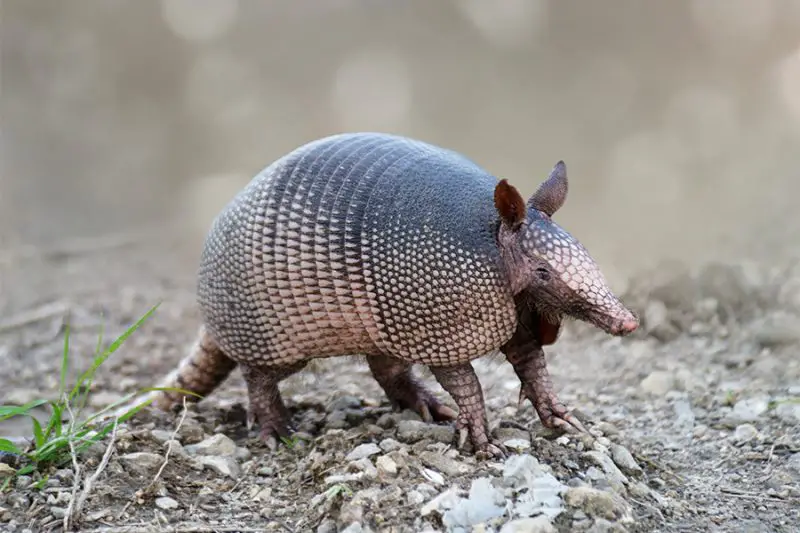Armadillos represent one of the most remarkable and interesting creatures in Georgia. Known for their distinctive armored shell and unique behaviors, these small mammals often captivate wildlife enthusiasts and casual observers alike.
Though primarily nocturnal and elusive, armadillos have increasingly become a familiar presence in many regions of Georgia, where they adapt well to diverse habitats ranging from forests to suburban areas. Understanding their identification, behavior, and common locations is essential for anyone interested in studying or observing these intriguing animals.
Identification of Armadillos in Georgia

The nine-banded armadillo is the species most commonly found in Georgia. Their appearance is instantly recognizable due to their hard, protective shell composed of bony plates covered in leathery skin.
This armor extends from the head to the tail, forming a series of flexible bands that allow the armadillo to move with surprising agility despite their defensive structure. Adult armadillos typically measure between 15 to 20 inches in length, with the tail adding an additional 14 to 17 inches. Their weight usually ranges from 8 to 17 pounds, although some individuals may be slightly larger depending on food availability and habitat conditions.
The head of an armadillo is small with a pointed snout, adapted perfectly for digging and probing soil for insects, grubs, and other invertebrates. Their ears are relatively long and flexible, providing acute hearing that compensates for their less developed eyesight.
The legs are short yet powerful, ending in strong claws specialized for digging burrows and unearthing food. Armadillos are covered in coarse, dark brown to gray fur along the edges of their shell and on the underside of their bodies, while the dorsal surface is primarily armored. This combination of armor and fur gives them a rugged but distinctive look that is unmistakable to anyone familiar with Georgia’s wildlife.
Juvenile armadillos look similar to adults but are smaller and have more pronounced ridges on their shells. Their coloration may appear slightly lighter, and their claws are proportionally larger relative to their bodies, which assists them in learning to dig effectively.
Observing these young armadillos in the wild provides valuable insight into the early development of their survival skills and social behaviors.
Behavior of Armadillos in Georgia
Armadillos are primarily nocturnal animals, meaning they are most active during the night. They forage for insects, worms, and other small invertebrates, using their keen sense of smell to locate food underground.
Despite their small size, armadillos are capable diggers and can create extensive burrow systems. These burrows serve multiple purposes, including shelter from extreme weather, protection from predators, and a safe place to rear young. It is not uncommon for a single armadillo to maintain several burrows within its territory, which they rotate between depending on food availability and environmental conditions.
One of the most remarkable aspects of armadillo behavior is their method of defense. Although they cannot roll completely into a ball like some other armadillo species in South America, their tough armor provides significant protection against many predators, including coyotes and bobcats.
When threatened, they often flee quickly, digging into the ground if necessary or sprinting short distances with surprising speed. Their agility and armored body make them difficult targets, allowing them to survive in areas with high predation pressure.
Armadillos are generally solitary creatures, coming together only during the breeding season or when a mother is raising her young. Courtship involves a series of distinctive behaviors, including sniffing, circling, and gentle nudging.
Females give birth to litters of identical quadruplets, a unique characteristic among mammals. These young are born with soft shells that harden within a few weeks, and mothers invest significant time in teaching them foraging and digging skills. Observing armadillo mothers with their offspring offers a rare glimpse into their social structure and maternal behaviors, which are otherwise largely solitary.
The impact of armadillos on the ecosystem is significant. By feeding on insects, they help control populations of pests that might otherwise damage crops or gardens. Their burrowing activity also aerates the soil, promoting plant growth and creating microhabitats for other species.
Despite their benefits, armadillos can sometimes conflict with human activity, particularly when they dig in lawns, golf courses, or garden beds. Understanding their behavior can help residents and wildlife enthusiasts coexist peacefully with these fascinating mammals.
Where to Spot Armadillos in Georgia
Armadillos are adaptable and can thrive in a variety of habitats across Georgia. They are commonly found in forests, grasslands, marshy areas, and even suburban neighborhoods. Preferring areas with loose, sandy soil, they tend to avoid regions with dense clay or heavily compacted ground, which makes digging more difficult.
In southern Georgia, armadillos are particularly abundant, where the climate and soil conditions provide ideal foraging and burrowing opportunities.
Observing armadillos requires patience and timing, as they are primarily nocturnal. The best chance of seeing them is during the early evening or just before dawn, when they begin their foraging activities. Roadsides, forest edges, and the peripheries of fields are often good locations to spot armadillos, as these areas provide both food sources and cover from predators.
In suburban and rural communities, armadillos may be seen wandering across backyards or near gardens, where insects and grubs are plentiful. Driving slowly at night through rural areas can sometimes reveal their reflective eyeshine or their distinctive, deliberate movement across the road.
State parks and wildlife reserves in Georgia also offer excellent opportunities for observing armadillos in their natural habitat. Parks with mixed hardwood forests and open meadows, such as Okefenokee Swamp and Chattahoochee National Forest, provide environments where armadillos can thrive and be observed safely.
These areas allow visitors to watch their natural behaviors, such as digging, foraging, and interacting with the environment, without disturbing their daily routines.
Armadillos are surprisingly resilient and have expanded their range northward in recent decades. This expansion is partially due to the lack of natural barriers and their ability to adapt to a variety of climates and soil types. Consequently, sightings are becoming more frequent in northern Georgia, including suburban counties where green spaces and wooded areas provide sufficient cover.
Wildlife photographers, researchers, and nature enthusiasts increasingly report regular encounters with armadillos throughout the state.
Seasonal Patterns and Activity
Armadillos in Georgia display seasonal variations in activity that are closely linked to temperature and food availability. During the cooler months, they may reduce their foraging activity and spend more time in their burrows to conserve energy.
Although they do not hibernate in the traditional sense, prolonged periods of cold weather can limit their movement and foraging efficiency. Conversely, during the warm spring and summer months, armadillos are highly active, often traveling significant distances each night to locate insects and other invertebrates.
The breeding season, which typically occurs in late summer or early fall, is another period when armadillo behavior becomes more noticeable. Males may increase their range temporarily while seeking females, leading to occasional sightings in areas where they are not usually observed.
After mating, the unique delayed implantation process allows the female to give birth approximately seven months later, ensuring that young are born in optimal conditions for survival. Understanding these seasonal patterns is essential for anyone studying or attempting to observe armadillos in the wild.
Interaction with Humans
As armadillos continue to expand their range in Georgia, interactions with humans have become more common. While they are generally non-aggressive and avoid confrontation, their digging can sometimes cause damage to lawns, gardens, and golf courses.
Homeowners may notice small holes in the yard or disturbed soil where armadillos have been searching for insects. Education about their behavior and ecological role is important, as it helps reduce unnecessary conflict and encourages coexistence.
Wildlife professionals emphasize humane methods for managing armadillo activity near human dwellings. Techniques such as habitat modification, including removing brush piles and filling in burrows, can discourage armadillos from frequenting residential areas.
In some cases, fencing can be used to protect gardens or small lawns from excessive digging. Importantly, armadillos are protected by state and federal regulations in certain contexts, so direct harm or unregulated trapping can be illegal. Observing them responsibly and maintaining respect for their ecological role ensures that both humans and armadillos benefit from coexistence.
Conservation Status and Ecological Impact
The nine-banded armadillo is not currently considered endangered or threatened in Georgia. In fact, its population is increasing as the species continues to expand northward.
Despite this, monitoring is important to understand potential ecological impacts, particularly in areas where their burrowing could disrupt native plant communities or alter soil composition. Armadillos play a key role in controlling insect populations, which benefits both agriculture and natural ecosystems. Their presence in Georgia contributes to biodiversity and offers valuable research opportunities for scientists studying mammalian ecology.
Conservation efforts focus on maintaining healthy habitats and ensuring that human expansion does not unnecessarily disrupt their populations. By preserving forests, wetlands, and open meadows, Georgians can support armadillo populations while also benefiting numerous other wildlife species.
Educational programs that teach local communities about armadillo behavior and ecological importance foster a sense of stewardship and appreciation for these unique mammals.
Observing Armadillos Safely
For those interested in observing armadillos, safety and respect for wildlife are paramount. Armadillos can carry diseases such as leprosy and are known to harbor parasites, so direct contact should be avoided.
Using binoculars or cameras with zoom lenses allows for close observation without disturbing their natural behavior. Nighttime observations require caution, as armadillos are often near roadways, and drivers must be alert to avoid collisions.
Patience is also key when attempting to spot armadillos. Because they are nocturnal and shy, sightings may be brief or require waiting in quiet areas where they are known to forage. Taking time to learn their habits, preferred habitats, and seasonal activity patterns greatly increases the likelihood of observing them in a natural and undisturbed state.
Recording observations, such as burrow locations and foraging trails, can also contribute to citizen science projects and research efforts.
Conclusion
Armadillos in Georgia are a fascinating and increasingly common component of the state’s wildlife. Their distinctive armored appearance, nocturnal behaviors, and adaptability make them both intriguing and ecologically significant.
Understanding how to identify armadillos, observing their behavior responsibly, and knowing where to find them enhances the experience for wildlife enthusiasts, photographers, and researchers alike.
As these resilient mammals continue to expand their range, Georgians have the opportunity to appreciate and coexist with one of the state’s most unique and captivating creatures. Through careful observation, habitat conservation, and respectful interaction, armadillos will remain an enduring symbol of Georgia’s diverse wildlife for generations to come.
FAQs About Armadillos in Georgia
What species of armadillo are found in Georgia?
The nine-banded armadillo is the most common species in Georgia. It is easily identified by its armored shell, pointed snout, and digging claws.
Are armadillos dangerous to humans?
Armadillos are generally not aggressive. However, they can carry diseases like leprosy and should not be handled directly.
When is the best time to see armadillos in Georgia?
Armadillos are nocturnal, so early evenings or just before dawn provide the best chances of observing them in the wild.
Where can I spot armadillos in Georgia?
They are found in forests, grasslands, wetlands, and suburban areas with loose soil suitable for digging.
How do armadillos affect the ecosystem?
Armadillos help control insect populations and aerate the soil through their burrowing activity, benefiting both natural habitats and gardens.
Do armadillos dig burrows?
Yes, armadillos dig extensive burrow systems for shelter, raising young, and protection from predators.






